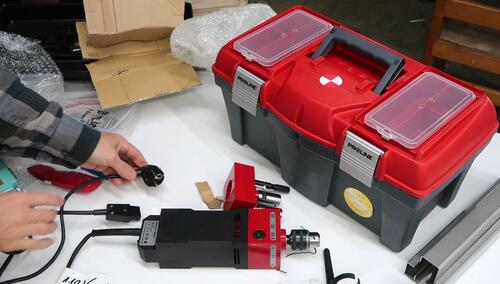 Krzysiek Brzeziński, from Poland, sent me his new product, a sort of
square drill. Not for drilling square holes, but a square drill for round holes.
Krzysiek Brzeziński, from Poland, sent me his new product, a sort of
square drill. Not for drilling square holes, but a square drill for round holes.
 Krzysiek Brzeziński, from Poland, sent me his new product, a sort of
square drill. Not for drilling square holes, but a square drill for round holes.
Krzysiek Brzeziński, from Poland, sent me his new product, a sort of
square drill. Not for drilling square holes, but a square drill for round holes.
The idea of this drill is that with it's simple and sturdy rectangular housing, it can be slid along a guide for repeatably drilling holes in precise locations.
The drill isn't regularly available in North America at this point, but the drill he sent me is a 110 volt version, but it came with a European 240 volt plug. I didn't want to cut the power cord off it just yet, so for the time being I taped a 120 volt power cord to the prongs of the European 240 volt plug.
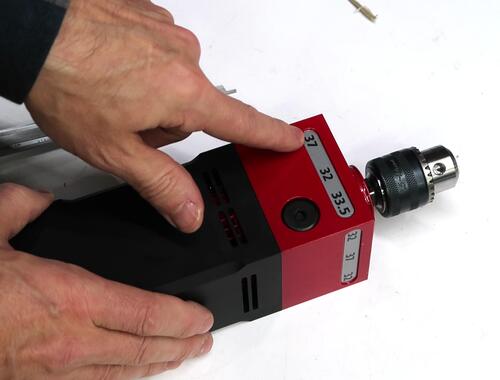 The housing shows how many millimeters the drill's axis is from each face
of the drill.
The housing shows how many millimeters the drill's axis is from each face
of the drill.
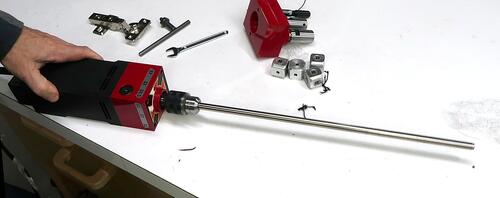 I put a precision ground shaft in the chuck and spun it up. The shaft
spun with very little wobble compared to a hand drill.
I put a precision ground shaft in the chuck and spun it up. The shaft
spun with very little wobble compared to a hand drill.
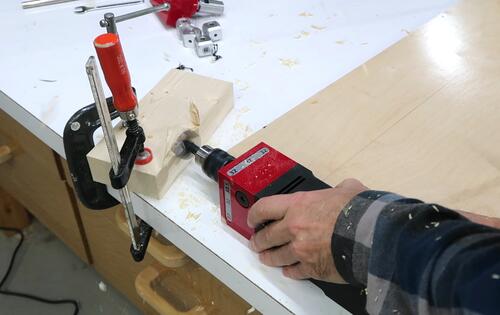 For my first test, I figured I'd try something that would be impossible
with a hand drill. Drilling a partial hole with a Forstner bit into
and angled piece of wood, with the center of the drill bit out of the wood.
For my first test, I figured I'd try something that would be impossible
with a hand drill. Drilling a partial hole with a Forstner bit into
and angled piece of wood, with the center of the drill bit out of the wood.
The dill started out well enough, but I wasn't able to hold the drill down firmly enough and it jumped on me a few times.
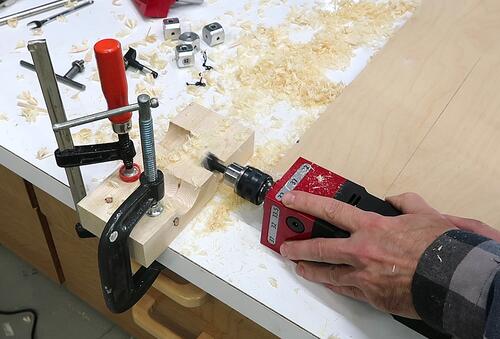 But with a smaller, 19 mm Forstner bit, I was able to drill a clean
partial hole in the wood. This sort of drilling would
be challenging even with a drill press, though it was something
I could do with my old horizontal boring machine.
But with a smaller, 19 mm Forstner bit, I was able to drill a clean
partial hole in the wood. This sort of drilling would
be challenging even with a drill press, though it was something
I could do with my old horizontal boring machine.

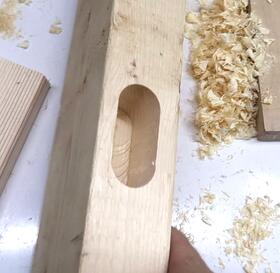 My next test was to drill a series of overlapping 19 mm holes
in a piece of wood. I used different spacers to guide the drill
for the different positions, then moved it freehand to open the
hole up into a slot.
My next test was to drill a series of overlapping 19 mm holes
in a piece of wood. I used different spacers to guide the drill
for the different positions, then moved it freehand to open the
hole up into a slot.
So this drill can be used as a sort of hand-held slot mortiser.
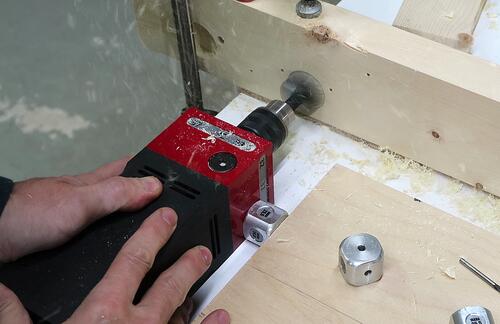
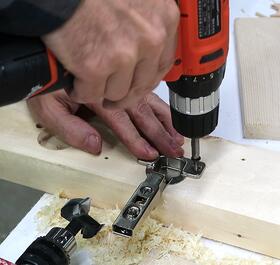 Krzysiek also sent along some cabinet hardware, including two European
style hinges. Using different spacers for the large hole and the two
screw holes, I was able to position the holes precisely without marking them.
Krzysiek also sent along some cabinet hardware, including two European
style hinges. Using different spacers for the large hole and the two
screw holes, I was able to position the holes precisely without marking them.
That said, it was a few steps to do this, and I think a simple jig to drill through would do the job more conveniently.
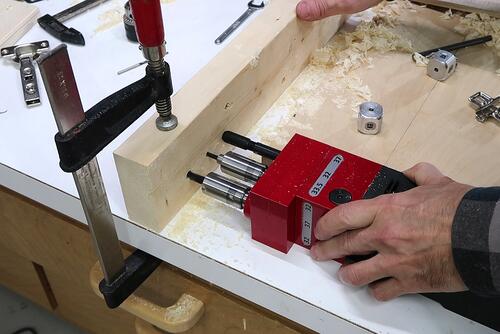 There is also a head with two spindles that can be screwed onto
the front of the drill (after removing the drill chuck). This head has
two spindles spaced 32 mm apart. This drill head only takes drills with
10 mm shanks. The kit included two drill bits with 10 mm shanks,
sized 4 and 9 mm. The third black
thing next to the drilling spindles is a stop for controlling the
depth of drilling.
There is also a head with two spindles that can be screwed onto
the front of the drill (after removing the drill chuck). This head has
two spindles spaced 32 mm apart. This drill head only takes drills with
10 mm shanks. The kit included two drill bits with 10 mm shanks,
sized 4 and 9 mm. The third black
thing next to the drilling spindles is a stop for controlling the
depth of drilling.
A lot of European cabinet hardware uses 32 mm increments for where the holes are placed. so this double head could cut down on the number of steps for some things.
I thought about ordering some more drills with 10 mm shanks to use wit this attachment, but this sort of drill is generally used in industry on multi-headed spindle boring machines, not by consumers. And the bits are much more expensive than regular drill bits.
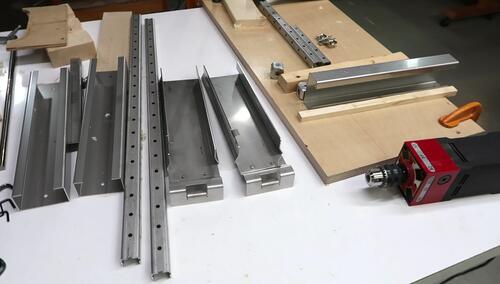 Krzysiek also sent a whole bunch of stainless steel parts. Some of these
act as 32 mm and 64 mm spacers to offset the drill in 32 mm increments.
But these are not as accurate as a plywood spacer would be. Getting the
dimensions of bent sheet metal precise is difficult.
Krzysiek also sent a whole bunch of stainless steel parts. Some of these
act as 32 mm and 64 mm spacers to offset the drill in 32 mm increments.
But these are not as accurate as a plywood spacer would be. Getting the
dimensions of bent sheet metal precise is difficult.
There were also two brackets that the drill fits into, and some rails with 4 mm holes at 32 mm increments. I was a bit at a loss as to how some of these should be used and emailed Krzysiek to ask.
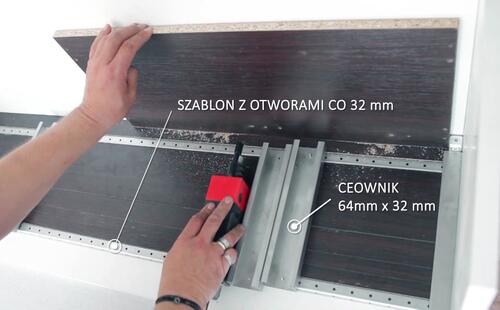 He sent me a link to
this polish video demonstrating the use of the drill. Here are
two screenshots from the video.
He sent me a link to
this polish video demonstrating the use of the drill. Here are
two screenshots from the video.
The video shows the drill used in a sort of box (which is white on the inside). The parts are lined up inside this box, and the box itself often acts as the guide for the drill. The rails with the holes can be used to index to different positions in 32 mm increments. Spacer blocks are used to raise 18 mm thick particle board workpieces to drill into the middle of the edges.
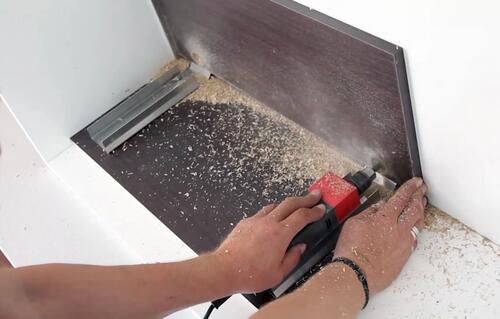 And the odd-shaped brackets are for drilling the large holes for mounting
Euro-hinges to correspond with where the mounting holes were drilled.
And the odd-shaped brackets are for drilling the large holes for mounting
Euro-hinges to correspond with where the mounting holes were drilled.
From this I gather that the main idea of this drill is to help drill holes
to attach mounting hardware in particle board. This is an application I never
really thought much about. As a hobbyist woodworker, I never use particle board.
Krzysiek included an assortment of cabinet fasteners. These are all for
mounting pieces of particle board at a right angle to each other. And come
to think of it, cabinets are all about mounting pieces to each other at
right angles.
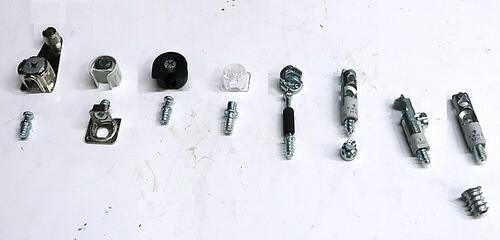
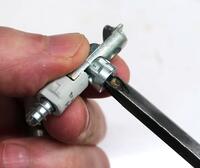 For me, a glued dowel joint would make more sense, or to just put
a screw through both pieces. But if what is made is to be flat packed and
assembled on-site, gluing may not be
practical, and screwed joints are hard to get just right, so it makes sense
to spend more money on hardware to make it easier.
For me, a glued dowel joint would make more sense, or to just put
a screw through both pieces. But if what is made is to be flat packed and
assembled on-site, gluing may not be
practical, and screwed joints are hard to get just right, so it makes sense
to spend more money on hardware to make it easier.
The most interesting of these fasteners is the one at right. It's slid into a 10 mm hole, then another part is inserted through another hole from the side. It forms a right angle gearing so a screwdriver can be used from the side to turn the screw part on the end. Its by ITALIANA ferramenta, type "Target J10"
But I work mostly with solid wood, so I'm not the intended target for this drill.
But making furniture out of particle board is usually done on a larger scale, using either multi-headed automatic spindle boring machines, or CNC to drill the various holes. But this is a business I have little exposure to. But I imagine a hand-operated drill wouldn't be the best tool for manufacturing at scale. And at a smaller scale, just using regular screws or glued dowels might make more sense, unless the furniture needs to be shipped flat packed and assembled on site.
But I imagine for some specialty applications, this drill would come into it's own. Or for cases where one or two extra holes need to be drilled in the workpieces that the automated machine can't get at, such as holes in the edges of the material, so that a final step would be to use this drill to drill an extra one or two holes.
Or it could be used on-site when assembling the pre-cut and pre-drilled pieces, when it turns out a few extra holes are necessary.
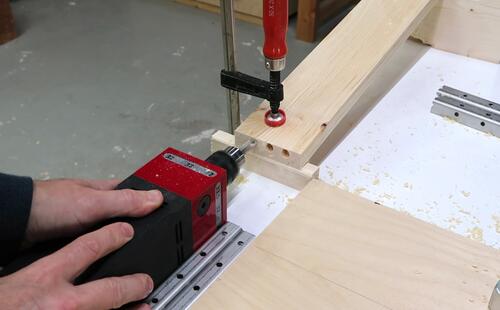 For me, for some specific problems, a drill like this is can do things that no other
jig could, such as drilling these angled dowel holes into the end of a long
piece of wood, where in the past I would have used my
horizontal boring machine.
For me, for some specific problems, a drill like this is can do things that no other
jig could, such as drilling these angled dowel holes into the end of a long
piece of wood, where in the past I would have used my
horizontal boring machine.
It's the right tool for where I used my horizontal boring machine, such as this chair repair, or making marble run blocks. That said, I used my horizontal boring machine very infrequently and it was very heavy, which is why I sold it when we moved. I kind of regret having sold it, but I only used it about once a year.
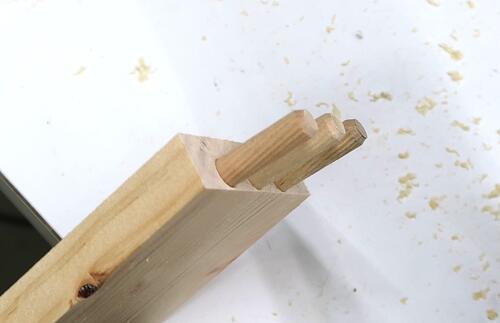 So that makes this drill very much a specialty tool.
So that makes this drill very much a specialty tool.
But I really like the idea of a drill like this. In fact, back in around 2007, I tried building a similar functioned horizontal boring jig using a guide clamped to a hand drill. But this setup lacked the necessary stiffness for how I wanted to use it, and I never used it again after I built it. Also, I built my horizontal boring machine two years later.
And it does a fine job making slot mortises with a drill (better than drilling mortises with a drill press). And that opens up some possibilities.
There is some information about this drill on the web, but all of it in Polish, unfortunately.
www.wiertarkaiskra.pl (polish)
Google translated to English
www.facebook.com/WiertarkaIskra
www.instagram.com/wiertarka_iskra/
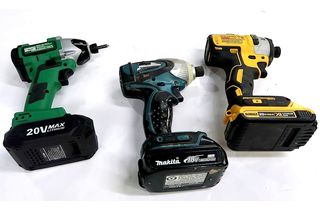 How impact drivers prevent screw cam-out (video only)
How impact drivers prevent screw cam-out (video only)